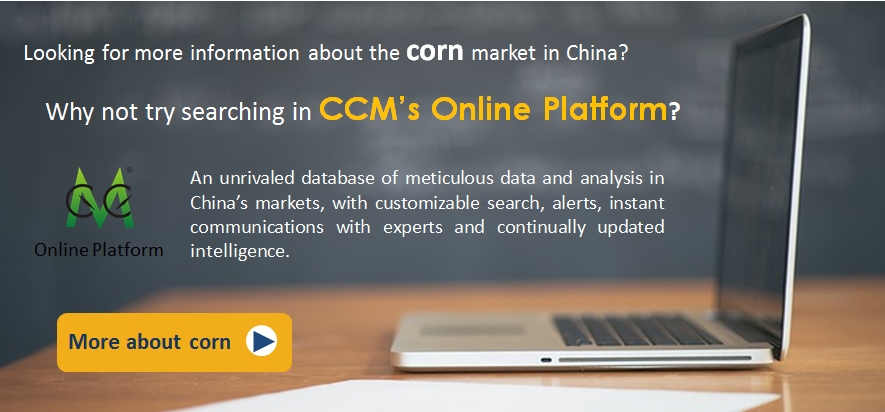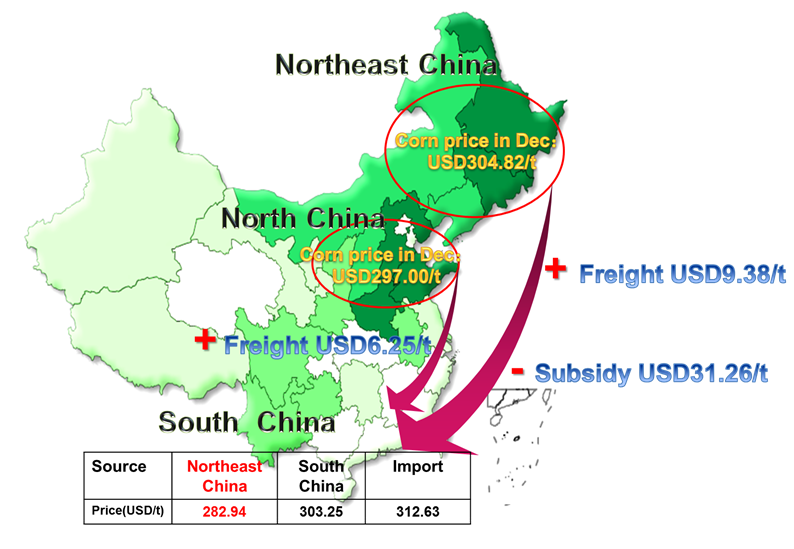In Dec. 2015, facing huge
inventory of temporarily-stored corn and unsalable corn in many places, Chinese
government is expected to re-implement the subsidy policy on corn
transportation. CCM believes this will change the supply pattern of the corn
industry and offer northeast corn more obvious cost advantage.
In Dec. 2015, corn is unsalable
in many places of China due to the new peak of corn output. Meanwhile, the
inventory of temporarily-stored corn is also very high in China. Therefore, the
discuss on whether Chinese government should re-implement the subsidy policy on
corn transportation to consume the inventory and to boost the activity of
sending grains from the North to the South becomes a hotspot nowadays. Data
from the China National Grain & Oil Information Center (CNGOIA) show that
the corn output will hit a record high in 2014/2015, being 219 million tonnes,
up 2.41% year on year. As of 1 Dec., China's corn inventory has reached 180
million tonnes.
The subsidy policy on corn
transportation means that the government will provide a one-time subsidy for
those feed enterprises in southern feed consuming provinces that transport corn
from Heilongjiang Province, Jilin Province, Liaoning Province and Inner
Mongolia Autonomous Region for sales, processing or storing.
Since China has implemented
temporary purchase and storage policy for 8 years, Chinese government has
offered southern feed enterprises twice subsidies on corn transportation.
In 2009/2010, the subsidy was
USD10.95/t (RMB70/t). At that time, China's corn deep-processing and feed
industries embraced rapid development. Meantime, Northeast China suffered from
droughts, which reduced the corn output. Sourced from the CNGOIC, the corn
output was 164 million tonnes, down 7%-9% compared to the last year. The market
presented a situation where supply fell short of demand. In order to promote
the fair competition of feed enterprises in the South and the North, Chinese
government carried out subsidy policy.
In 2013/2014, the subsidy was
USD21.90/t (RMB140/t). Affected by the serious bird flu took place in China in
April 2013, the poultry farming industry was in downturn, suppressing the
demand for downstream feed products. At that time, the inventory of
temporarily-stored corn was about 75 million tonnes. To stimulate the operating
rate of enterprises, Chinese government formulated the subsidy policy.

According to analyst CCM, it is
very likely for China to implement subsidy policy for corn transportation again
in the future.
Firstly, regarding the current
inventory, the corn inventory has reached 180 million tonnes in China, as of 1
Dec. The figure is 2.4 times that in 2013/2014. The government faces
unprecedented pressure on inventory.
Secondly, Chinese government is
under the pressure of public opinion of policy fault since corn is found
unsalable in many places. How to stimulate the production of downstream
enterprises quickly and effectively to consume the corn becomes the urgent
affair.
Thirdly, since Jilin Province
(Northeast China) enjoys the processing subsidy of USD54.71/t (RMB350/t), it is
of obvious cost advantage. In order to ensure the fair competition, it is
reasonable to subsidize southern enterprise on transporting corn.
In the cast of the supply,
southern feed enterprises should have been inclined to purchase northeast corn
because Northeast China has large corn planting areas for them to select.
However, the long transport distance results in high transportation cost.
Besides, the northern corn price was significantly declined in Oct. 2015. At
the end of Oct., the purchase price of northern corn was USD257.92/t
(RMB1,650/t), down 6.89% compared to the early of Oct. And the average price of
northeast corn was USD289.18/t (RMB1,850/t) in Oct., which was obviously higher
than that of northern corn. Thus feed enterprises are more willing to purchase
northern corn (For more details, please refer to the Northern corn squeezing
northeast corn market in China in the Corn Products China News 1510).
Currently, it is generally
predicted that the transportation subsidy would be about USD31.26/t (RMB200/t)
in 2015. If the subsidy policy is implemented, it can reduce the purchase cost
of southern feed enterprises and will change the supply pattern of corn,
offering northeast corn more obvious cost advantage.
Comparison of cost advantages of Northeast
corn and Northern corn after implementation of transport subsidy

Note: The transportation cost is calculated based on shipping.
Source: CCM

About CCM:
CCM is the leading
market intelligence provider for China's agriculture, chemicals, food
& ingredients and life science markets. Founded in 2001, CCM offers a
range of data and content solutions, from price and trade data to
industry newsletters and customized market research reports. Our clients
include Monsanto, DuPont, Shell, Bayer, and Syngenta. CCM is a brand of
Kcomber Inc. More about CCM, please visit www.cnchemicals.com.
We will attend FIC in the coming week. If you would like to meet us for consultancy in FIC, please get in touch with us directly by emailing econtact@cnchemicals.com or calling +86-20-37616606.